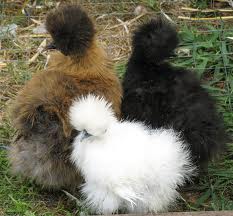Being a fan of the Hannibal TV series - yes, that's right - a fannibal - I am checking out all the affiliated reports, blogs and websites (I am poor, and don't have Sky Living).
And lo and behold, I manage to find something that relates with my little blog!
In the episode 'Releves' Hannibal is visiting FBI profiler Will Graham in hospital (I think). He has brought with him two bowls of soup, of which he tells Will is "Silkie chicken in a broth". This, is "a black boned bird, prized in China for its medicinal values since the 7th century" with "wolfberries, ginseng, ginger, red dates and star anise".
He is correct: the Silkie chicken (烏骨雞) is an ancient breed that originates from China - records show that Marco Polo wrote about them on his travels. The Silkie chicken is highly distinguishable by its fluffy plumage that feels like silk - hence the name. It is kept as an ornamental pet as well as for its eggs and its meat. Underneath the feathers, the Silkie has black skin, black bones and grey/black meat, a rather unusual sight for poultry. They are less meaty compared to poultry used in roasts, and has a taste and texture like game. They also produce small eggs. I have yet to see Silkie chickens being served in the UK - you can find them in Chinese supermarkets, but not often. In Chinese cuisine they are commonly served cooked in broths, sometimes with the skin removed to reduce the fat content.
Silkie chickens - from chickenforum.com (where else!)
From the kitchn.com
Silkie chicken broth - from Mama Tong Soups.
In Asia, Silkie chicken is considered to be a food that has great restorative properties (補), in the sense that it acts as a tonic for building up blood (補血). It is not uncommon for Silkie chicken broth to be given to women during pregnancy and after childbirth.
Other ingredients in the broth can be just about anything, including carrots, sweetcorn and mushroom - it is chicken soup, after all. However, the use of herbal ingredients maximises the effect of the broth's curative properties, and hence distinguishes the broth to be used as a medicine. The addition of wolfberries (goji berries), ginseng, ginger and red dates has the purpose of warming and energising the body, thereby helping to cure chills, fever; strengthen the immune system; replenish the blood and improve circulation. It is very much something reserved for the elderly, or those who are very unwell. (Note - I am not too sure about star anise as a medicinal property here - in my knowledge it is used as a spice, and as part of the Chinese five spice mixture. I have not heard of it being used as an ingredient with chicken in a medicinal broth).
So, it is good that Dr. Lecter is looking after Will and helping him build his strength - but for what purpose???
I will have to save my pennies and buy the box set to find out.
Sources:
Mads Mikkelsen tumblr
As with anything for medicinal purposes, such foods should be taken with caution. Ginseng, red dates and goji berries have "inflammatory" properties that can cause side effects - such as nose bleeds, headaches, nausea and diarrhoea. They can also interfere with the actions of certain drugs, such as warfarin. Those with weak livers, have known allergies, or are taking any kind of medicine should consult their doctor.













